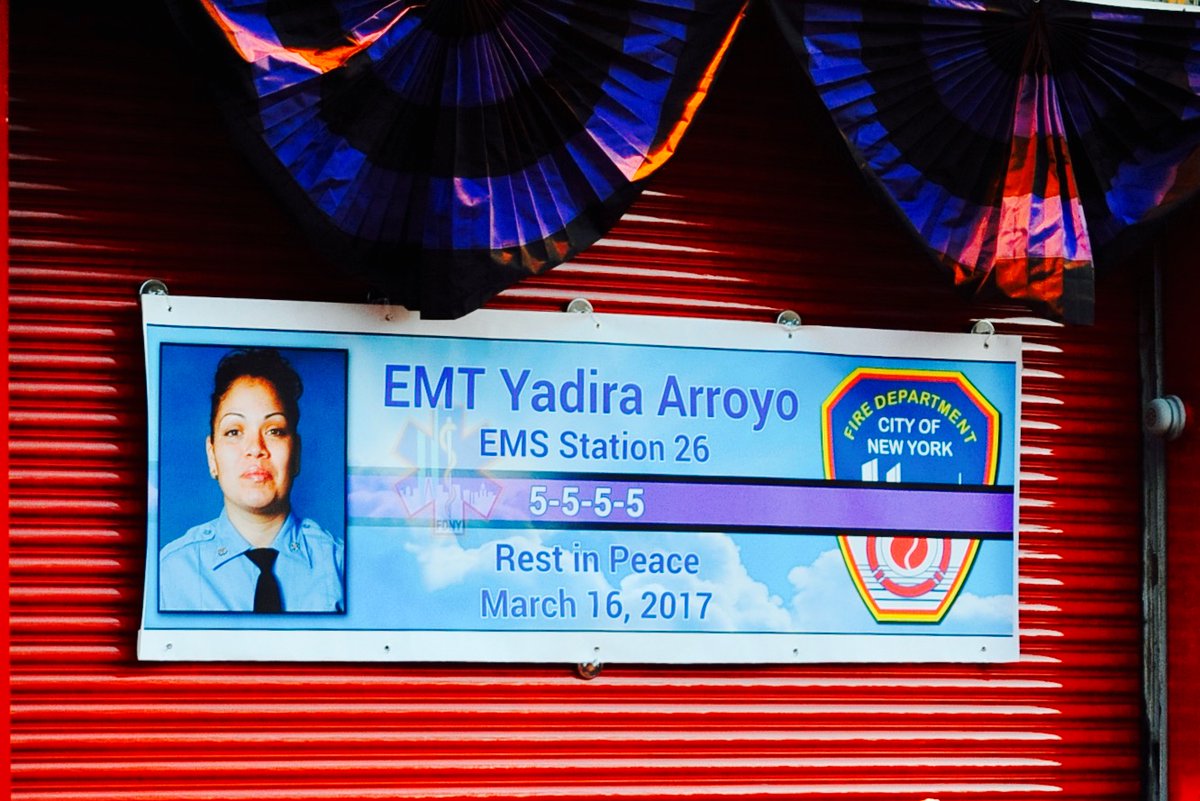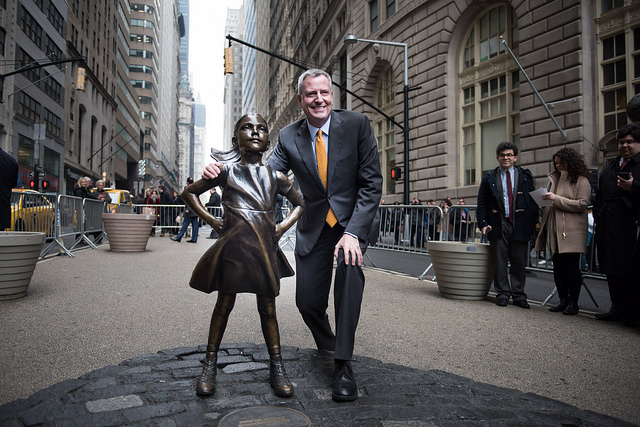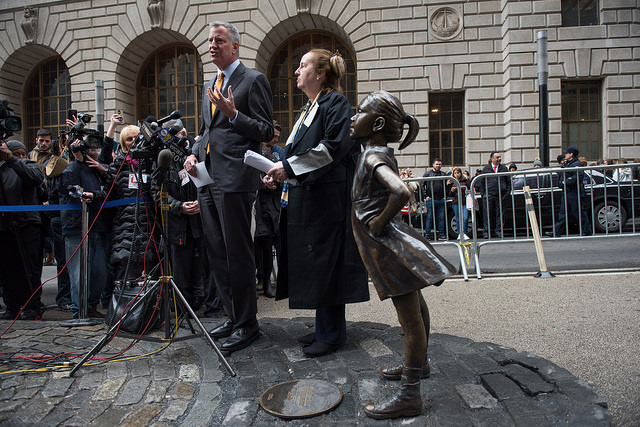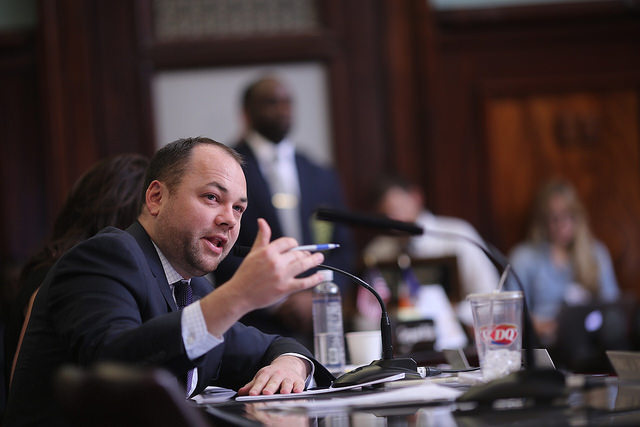Killing of FDNY EMT Spotlights Issues for Unsung Profession
;
(photos: @FDNY)
Of the city’s various uniformed workers, some dominate media attention and public awareness. Along with the historical presence and mythology of firefighters and police officers, corrections officers have been in the news recently, mostly for the wrong reasons, while New Yorkers rely on sanitation workers for a basic essential of city life.
Public soul-searching over questions about broken windows policing and the future of the Riker’s Island jail also have many New Yorkers thinking about police and corrections officers, with ongoing policy discussions now moving into a city election year.
Yet one uniformed group, which like the others has a unique set of responsibilities, labor issues, and policy priorities, has found itself largely locked out of the conversation, even as its 4,700 members continue to risk their own well-being and save lives on a daily basis: FDNY emergency medical service (EMS) workers, which include EMTs and Paramedics.
The service came suddenly into the limelight on March 16 when Yadira Arroyo, 44, a 14-year veteran of the FDNY EMT and mother of five, was killed, allegedly by a 25-year-old Bronx man who commandeered her ambulance and ran her over.
“The primary concerns have not changed for many years,” said Izzy Miranda, president of Uniformed EMTs, Paramedics & Fire Inspectors Local 2507, in an interview a few days after Arroyo was killed on the job. “We get resistance from the administration no matter which one it is. We’re truly not recognized by the administration as a true uniformed service.”
His members’ primary concern is pay, Miranda said. Base salary for an FDNY EMT after five years on the job is $47,685. A firefighter, meanwhile, can expect to take home $85,292 in base pay after five years, the same as an NYPD officer after 5.5 years.
“They have to work overtime, second and third jobs…We lose the best quality people,” said Miranda, explaining that members turn to private sector jobs like nursing because they cannot afford to live in the city on EMT pay.
That’s the case for FDNY rescue medic Usman Rahyab, an 11-year veteran of the department, who had worked with Arroyo and described her as someone who “sincerely loved her job.”
“I have to teach on my days off, I have to work overtime,” Rayhab said. “I teach paramedics to make enough money to support myself and my son…My own barber makes more money than I do, and he cuts my hair.”
Rayhab also painted a picture of an agency with a multitude of internal budgetary and management issues, and a punishing work culture that drives out talented medical workers.
“We’re constantly, constantly running out of essential equipment. We’re allowed to go out there and respond and not have that. That’s because of the budget,” he said, citing the example of CPAP devices, which can prevent a patient from having to be intubated. “Right now, at this time, I do not have any in my truck. They still send me out…I shouldn’t be told ‘do what you have to do, do the best with what you have,’” he added.
In an email, Frank Gribbon, a spokesperson for the FDNY, denied there is any shortage of the devices, writing “I'm told we do not have a shortage of CPAP devices - plenty in stock.”
A report by the Citizens Budget Commission in December 2015 calculated that just 13% of the FDNY’s budget for fiscal 2015 was allocated for EMS, despite at least 75% of incidents to which the agency responded being medical in nature. The city’s EMS was moved from the Health and Hospitals Corporation to the FDNY in 1996 in an attempt to increase coordination between emergency services and reduce redundancies.
Gribbon said that “the budget for EMS has never been greater, having been increased by nearly $40 million two years ago by the Mayor” and specified that the cost of running EMS was $600 million, with $180 million recovered through insurance billing. He did not answer a question about how the EMS operating budget was calculated internally.
Rayhab also outlined functional and cultural problems within the agency, claiming that members were stretched so thin they could go 12 hours without a single break, even to eat. If discovered eating at an unsanctioned time, he said, they could lose “four or five days worth of pay.”
When paramedics get hurt, Rayhab said, “you’re either going to recover, you’re going to get demoted, or you’re going to lose your job. There’s nothing else. And there’s a high injury rate.”
When an EMS worker does become injured to the point that they cannot continue to work, that can be an uncertain process.
Miranda, the union president, recently held a rally on the steps of City Hall with State Senator Marty Golden (R-Brooklyn) and Assemblymember Peter Abbate (D-Brooklyn) to introduce a bill that would allow New York state courts to grant disability pensions to EMS, corrections, and sanitation workers if they disagreed with a pension denial from the New York City Employees' Retirement System (NYCERS).
Currently, courts can only remand cases back the board. In a phone interview, Sen. Golden said “[EMS workers] fall, mess up their back, their head, they cannot function as an EMS, they’re forced into disability. They have to go back and forth between the panel and the supreme court if they’re denied. This takes time, and it takes money. It can be two years and $10,000 before they’re done.”
Golden also worries about the physical safety of EMS workers. In 2015 he introduced a bill, which passed and was signed by Governor Andrew Cuomo, removing a requirement that an assault on an EMS worker had to intend to obstruct their official duties for it to be considered assault in the second degree, a class D felony.
For Golden, who was a New York City police officer in the 1970s and early ‘80s, the death of Arroyo is part of a larger pattern of renewed violence against uniformed responders and peace officers. “I remember people throwing garbage cans on firetrucks and EMS vehicles,” Golden said of his time in the NYPD, adding, “it seems to be back to that. They want to attack anyone in uniform.”
Another point of contention is the EMS service’s own leadership. As opposed to their firefighter counterparts, the appointment and promotion of EMS supervisors does not require a competitive civil service examination, a situation Miranda said does not afford EMTs ample opportunity to advance. Rahyab was more blunt: “they promote their buddies…Our members do not look up to the EMS administration.” Golden has introduced a bill in the Senate to require the examinations.
On the municipal front, the EMS workers union has a few specific interests, starting with contract negotiations that will bring their compensation more in line with their uniformed colleagues. Miranda said that their next contract negotiations will begin around April of next year, but his union is open to starting conversations with the city now.
Miranda is also pushing a bill, introduced by Queens Council Member Elizabeth Crowley, who is chair of the Committee on Fire and Criminal Justice Services, that would require bulletproof vests for some EMS workers “meet certain safety requirements related to their warranty, history of use, and fit” and “meet standards for bullet resistance developed by the National Institute of Justice.” The bill is designed to upgrade vests that were issued to EMS workers under the Giuliani administration in the late 1990s.
Crowley said she was also advocating for funding for the vests in the city budget, regardless of whether the bill passes in the Council. “If the [fire] department believes it’s important to give every graduating EMT a bulletproof vest, why are they not upgrading that vest after five years, when it’s no longer effective?” she said.
Crowley also intends to introduce legislation that will require public reporting of so-called vital statistics, internal figures that provide more detail than the department’s annual reporting on fire fatalities. She mentioned that these statistics showed that lives saved by EMS were down year-over-year.
“Unfortunately, many of the calls they get now are about overdoses…So naloxone use should be part of the vital statistics,” she said as an example of what could be included. Echoing the irritation of EMS workers, she said that it “frustrated me in the past, and it frustrates me today that they’re treated like a second class public safety arm.”
 Both Rahyab and Miranda lamented the lack of attention that their profession’s struggles have received, but hoped that if there was one good thing to come out of the recent tragedy, it would be increased awareness.
Both Rahyab and Miranda lamented the lack of attention that their profession’s struggles have received, but hoped that if there was one good thing to come out of the recent tragedy, it would be increased awareness.
“It’s a shame that it has to take a tragedy, one of our sisters making the supreme sacrifice, for these issues to even be looked at,” Miranda said.
***
by Felipe De La Hoz, Gotham Gazette
@FelipeDLH @GothamGazette
De Blasio’s ‘Fearless’ Moment

De Blasio & "Fearless Girl" (photos: Michael Appleton/Mayor's Office)
Mayor Bill de Blasio walked swiftly down Broadway Monday afternoon with a big smile on his face. The mayor approached the entrance to a barricaded area in which he was about to address gathered members of the media and was stopped for a photo by a group of Girl Scouts. He gladly obliged, then proceeded, approaching the Wall Street Bull, but stopping a few yards short at his destination, the “Fearless Girl” statue.
De Blasio knelt beside the small statue that has become a symbol of female power and empowerment, and put an arm around the bronzed girl, posing for photos and smiling widely. Cameras shuttered from within the cordoned off triangle, which was filled with journalists and tourists, while other onlookers from surrounding sidewalks took in the scene and car traffic slowly proceeded toward Bowling Green.
The mayor then gave brief remarks at a makeshift podium featuring a bouquet of microphones, where he explained that the Fearless Girl would be permitted to remain installed and staring down the bull through next International Women’s Day, in March 2018. It was the mayor's first remarks to gathered members of the media since an ill-fated Thursday press conference that the mayor ended abruptly when he did not like the questions he was asked.
“[T]his statue, the Fearless Girl, means so much to the people of New York City – and I’m saying all the people of New York City,” said de Blasio, who was accompanied by Manhattan Borough President Gale Brewer. “I’ve been profoundly struck by what this statue means in particular to women, and to girls in this city, and this whole country. But I think there’s an even broader symbolism of standing up to fear, standing up to power, being able to find in yourself the strength to do what’s right.”
Just a few weeks ago, on this year’s International Women’s Day, March 8, when the Fearless Girl had seemingly appeared out of nowhere and became a social media sensation, de Blasio was caught unaware when asked about the statue at an unrelated press conference. The mayor promised a WNYC radio reporter that his office would soon provide a reaction, once he was briefed. Later that day, the mayor’s Twitter account announced “our future rests in the hands of fearless girls,” with a photo of the statue and a group of admirers. The tweet also said that the statue would be “standing tall in Lower Manhattan through April 2nd,” a timeline that has now been extended after public outcry, including from Public Advocate Letitia James.
James and de Blasio appeared together at a March 21 press conference on street safety. When the mayor was asked about the statue and James’ advocacy for its permanence, de Blasio half-jokingly called James "a fearless girl” in reference to work they had done together opposing former Mayor Michael Bloomberg’s term-limits extension. The mayor then said he was considering “prolonging” the statue’s “presence.”
“You know, some people have called for permanent action,” the mayor continued, “we’re hesitant to do anything permanent because, you know, that has ramifications for the whole city. But in terms of a longer presence, I’m open to that and we’re going to be looking at that.”
On Monday, James reacted to the city extending the statue’s presence, saying in a statement she is “pleased that the Mayor is extending her permit. However, the importance of empowering women is not temporary, and Fearless Girl must become a permanent fixture in our City as a reminder to all women that no dream is too big and no ceiling is too high.”
De Blasio’s visit to the statue was a late addition to his schedule. In his remarks, the mayor connected the statue to the women’s marches of January 21, which came the day after President Donald Trump’s inauguration, with “women and their male allies all over this country – hundreds of cities and towns – coming out to say that regardless of the results of an election, no one was going to affront women and the rights of women.”
“And right after that, this miraculous girl appears and created such a powerful sensation because she spoke to the moment,” de Blasio continued, “that sense that women were not going to live in fear, that women were going to teach their daughters and all the girls in their life to believe in themselves.”
 The Fearless Girl statue is a creation of Kristen Visbal, commissioned by State Street Global Advisors. Visbal has said in recent interviews that the statue shows a “brave, proud, and strong” person, not “defiant” or “belligerent,” but a symbol that women are unapologetically part of the “traditionally male environment” on Wall Street. A representative of State Street has said the statue represents “the power and potential of having more women in leadership.”
The Fearless Girl statue is a creation of Kristen Visbal, commissioned by State Street Global Advisors. Visbal has said in recent interviews that the statue shows a “brave, proud, and strong” person, not “defiant” or “belligerent,” but a symbol that women are unapologetically part of the “traditionally male environment” on Wall Street. A representative of State Street has said the statue represents “the power and potential of having more women in leadership.”
Some have called Fearless Girl a corporate public relations ploy and though James, Brewer, and other female civic leaders have championed the statue, the enthusiasm for it has been the source of much derision, including on social media, which can often be home to a great deal of negativity. Yet, New York Times columnist Ginia Bellafonte recently called Fearless Girl “corporate feminism” and noted that it could have been an effort at changing the subject or distracting from some recent bad news -- fraud charges -- for the State Street parent company, which the company denied.
De Blasio, a champion of regulating Wall Street who regularly calls for higher taxes on the wealthy, made no mention of the financial industry on Monday.
The mayor's appearance at the statue was the first time he had gathered the press to make remarks since Thursday's truncated media availability, when the mayor promoted his “mansion tax” proposal but refused to answer questions on other topics and shut the press conference down in frustration after three “off-topic” questions.
On Monday, de Blasio’s updated schedule, as emailed to members of the media, said that the appearance at Fearless Girl would not include any Q&A with the press, despite the fact that more than a dozen journalists were on the scene. After the mayor posed for photos, gave his remarks, and listened as Brewer gave hers, he quickly walked back up Broadway to a waiting car, ignoring reporters who started asking questions.
***
by Ben Max, Gotham Gazette
@tweetBenMax @GothamGazette
10 Key Data Points from Social Services Budget Hearing

City Council Member Corey Johnson (photo: William Alatriste)
The City Council General Welfare Committee conducted a budget hearing Monday to evaluate the programs, expenditures, and needs of the Human Resource Administration (HRA) and Department of Homeless Services (DHS). Steven Banks, Commissioner of the Department of Social Services (DSS), which oversees both HRA and DHS, provided testimony for the two agencies before taking questions from concerned Council members.
Though HRA provides a wide variety of services -- including job training and emergency food assistance -- the committee’s questioning focused almost exclusively on the city’s homelessness crisis and the lack of progress that has been made by the de Blasio administration.
“Is this something that New Yorkers are going to have to accept as a new norm?” asked Council Member Stephen Levin, chair of the committee. “Are we to look ahead to future years and future generations and accept that the reality is that there are going to be 50,000 individuals and families living in our shelter system?”
There are currently about 60,000 New Yorkers living in homeless shelters, and Mayor Bill de Blasio recently outlined the goal of reducing the population to about 57,500 over five years. While the mayor has admitted that his administration has not made enough progress reducing homelessness, he argues that the population would be around 70,000 if not for the rent subsidy and anti-eviction measures his team, led by Banks, has implemented.
Responding to Levin and committee members, most of whom were late to the hearing, Banks provided a comprehensive rundown of the investments DSS and the de Blasio administration have instituted, such as voucher programs and legal assistance to tenants facing unwarranted eviction.
He also discussed the HOME-STAT initiative, which has doubled the number of outreach workers on city streets in order to bring people into shelter. Though the committee acknowledged its support for these measures and conceded that significant investment has been made, they nevertheless stressed their dissatisfaction -- often bordering on outrage -- with the lack of progress, especially considering the concentration of resources targeted at homelessness. Expenditures for HRA and DHS have ballooned under de Blasio, and the mayor is proposing more money for the fiscal year 2018 budget, which is due by July 1.
In his $84.67 billion preliminary budget proposal, 18 cents of every dollar goes to social services, the second largest portion behind education. The mayor has allocated $7.5 billion for the Department of Social Services and $772 million for the Department of Homeless Services, though both numbers are likely lower than the adopted budget will show at the end of June.
At Monday's hearing, Council Members Barry Grodenchik, Corey Johnson, and Brad Lander were particularly critical of the administration’s efforts.
“It seems to me that this city has committed an immense amount of resources and...it doesn’t seem like we’re getting value for our dollars,” Grodenchik told Banks, questioning both the effectiveness and scope of the administration’s plan to stop using 360 cluster apartment and commercial hotel locations and open 90 new homeless shelters throughout the city. “It seems to me that the goal is not as ambitious as it needs to be.”
Banks defended “a concrete and realistic goal.”
Lander expressed frustration that is shared by de Blasio, his predecessor on the Council, and other stakeholders. “On the one hand I appreciate being realistic, on the other I appreciate that this is an absolute crisis and we need to do more,” Lander said, before proceeding to recommend that Banks and his team focus on “getting families into affordable, permanent public housing.”
The notion of placing more homeless families into public housing, through NYCHA, is something that some elected officials and advocates have long-called for, but that Banks and de Blasio have said is not the right approach. The mayor has cited the already-long NYCHA wait-lists.
“It’s disturbing to walk down the streets everyday and to see homeless people on nearly every block...even after all these efforts at homelessness prevention, it still feels like we are not being successful,” added Council Member Johnson, who represents Chelsea and Greenwich Village.
Banks’ testimony touched on other important DSS initiatives, in addition to homelessness, and provided updated data points on a variety of key topics:
--The Supplemental Nutrition Assistance Program (SNAP), which helps feed 1.7 million New Yorkers, including more than 650,000 children, added 8,371 participants in the last year. Asked about the future of SNAP in New York City, given the uncertain prospects for federal funding under the Trump administration, Banks said that he and the mayor would be working with Senators Chuck Schumer and Kirsten Gillibrand to retain SNAP funding for New York City recipients.
--According to Banks’ testimony, HRA provided rental assistance to 58,100 households in 2016 at a cost of $214 million. Asked about the widespread problem of landlords refusing to honor rental assistance programs and vouchers, Banks provided a phone number that residents can now call if they experience such refusal. Banks said HRA is determined to identify non-compliant landlords and compile a database of these individuals.
--Banks’ testimony also explained that HRA has eliminated the Work Experience Programs (WEP) in favor of Job Training Program slots at NYPD, Parks Department, Department of Sanitation, and Department of Citywide Administrative Services (DCAS). The programs will serve up to 210 cash assistance participants annually.
--The HIV/AIDS Services Administration (HASA) accepted 3,444 new clients from August 2016 through January 2017, which is 1,410 more than the same period from the previous year. This was result of an HIV expansion program that allowed “all financially-eligible New York City residents with HIV to seek and obtain HASA services.” Applicants previously had to have developed AIDS or be “symptomatic” to be eligible. Council Member Johnson, who chairs the health committee, spoke about the success of HASA as a key achievement.
--Banks’ testimony also announced a DHS plan to add 10,000 affordable apartments specifically for seniors, veterans, and New Yorkers earning less than $40,000 per household. DHS also has plans to institute an Elder Rental Assistance program, to be funded through the mayor’s “mansion tax,” to help more than 25,000 seniors with monthly rental assistance of up to $1,300. The mansion tax is unlikely to be approved in Albany, though.
--In 2016, DHS placed 3,153 homeless veterans in permanent housing.
--30% of families with children in a DHS shelter have a history of domestic violence. The Fiscal Year 2017 budget included $217 million for DHS security purposes.
--Banks also referenced the 24% drop in evictions citywide since the institution of free legal assistance programs for many New Yorkers facing eviction. More than 40,000 residents avoided eviction in 2015 and 2016. The mayor and the City Council recently agreed to expand such assistance further.
--Banks provided figures to demonstrate why the city has struggled to contain its homelessness problem. Between 2000 and 2014, Banks testified, median rent has increased 19%, while household income decreased by 6.3% over the same period.
--360,000 New Yorkers now spend more than 50% of their income on rent and utilities. Another 140,000 spend more than 30%.
--All in all, homelessness has increased by 115% over the past two decades. In 1994, 23,868 New Yorkers were homeless, by 2014, when Mayor de Blasio took office, that number was 51,470. It is now around 60,000.
Banks' testimony was followed by the General Welfare Committee's examination of the Administration for Children's Services.
***
by Luke Foley, Gotham Gazette
@GothamGazette




